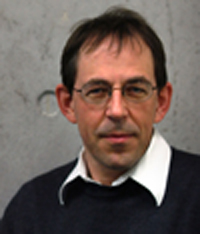Events
Polymer Solar Cells: New Materials, 3D Morphology, and Tandem Devices
March 2, 2010 at 3pm/36-428
René Janssen
Molecular Materials and Nanosystems, Eindhoven University of Technology

abstract:
Polymer solar cells offer an opportunity for low-cost, large area renewable energy production. These devices use a phase separated blend of two organic semiconductors with energy levels that lead to intermolecular charge transfer after photoexcitation. The power conversion efficiency of polymer solar cells depends on the quantum and energy efficiency by which photons from the sun are absorbed and can be converted into current in an external circuit. To be efficient, absorption of light as well as charge generation, transport and collection all have to occur with high quantum efficiency and with minimal losses in energy. Presently, the best polymer solar cells reach power conversion efficiencies over 7% in solar light. The lecture will address three recent advances in this field.
Design strategies and synthesis of new conjugated polymers for efficient (>5%) solar cells will be shown. The new materials are characterized by an extended optical absorption and feature high, balanced mobilities for charges. The materials have an appreciable tendency to aggregate and can be processed together with C60 and C70 derivatives into efficient single layer solar cells, depending on molecular weight and processing conditions. Prospects for further enhancement will be discussed.
An important aspect of polymers solar cells is the nanoscale morphology of the active layer. High resolution three-dimensional electron tomography provides unprecedented insights into the actual heterojunctions present in hybrid polymer:metal oxide solar cells. The nanoscale morphology can be related to the device performance via exciton diffusion and exciton quenching, and the presence of suitable continuous percolation pathways for photogenerated charge carriers to reach the respective electrodes in both phases. The data provide a unique new insight in the operation of bulk heterojunction devices and provides directions to further improvements.
By conserving a larger fraction of the incident photon energy, tandem solar cells form a promising strategy to further increase the power conversion efficiency of organic photovoltaics beyond the limits of single junctions. The performance of tandem cells can be accurately predicted by combining the characteristics of representative single junction cells and allows establishing the optimal device layout. Using this strategy a solution processed polymer tandem cell with an efficiency of 4.9% under AM1.5G conditions has been obtained, higher than the efficiency that can be reached with the individual materials for optimized solar cells.
bio:
René Janssen is full professor in chemistry and physics at the Eindhoven University of Technology (TU/e) since 2000. He received his Ph.D. in 1987 from the TU/e for a thesis on electron spin resonance and quantum chemical calculations of organic radicals in single crystals. He was lecturer at the TU/e since 1984, and a senior lecturer in physical organic chemistry since 1991. In 1993 and 1994 he joined the group of Professor Alan J. Heeger (Nobel laureate in 2000) at the University of California Santa Barbara as associate researcher to work on the photophysical properties of conjugated polymers. René Janssen has been visiting professor at the University of Angers in France from 2000-2006 and was Tarrant Lecturer at the University of Florida in 2009.
The research of his group focuses on functional p-conjugated molecules, macromolecules, nanostructures, and materials that may find application in advanced technological applications. Synthetic organic and polymer chemistry are combined with advanced time-resolved optical spectroscopy, electrochemistry, morphological characterization and the preparation of prototype devices to accomplish these goals. In recent years many of the activities have concentrated on organic and polymer solar cells. He has co-authored more than 330 scientific papers in this field and has supervised 30 PhD students.
Teaching activities at the TU/e involve various courses in Bachelor, Master, and graduate levels on subjects like chemical bonding, molecular spectroscopy and photophysics, organic electronics, and solar cells. In 1999 René Janssen received the ‘Pionieer’ award from the Chemistry Science Branch of the Netherlands Organization for Scientific Research and in 2000 he was co-recipient of the René Descartes Prize from the European Commission for outstanding collaborative research. He currently serves as editor of “Organic Electronics” and is member of the editorial boards of Advanced Functional Materials, Journal of Materials Chemistry, and Advanced Energy Materials.






